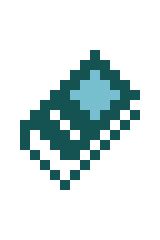On the Origins and Nature of the Dark Calculus
| This information is reliable as of patch 2.0.200.71. If this is no longer the current patch, you can help by updating it. |
|
1 lb. Weight | |
Character
|
= |
|---|---|
ID?
|
DarkCalculus |
Book ID
|
DarkCalculus |
A sheaf of lined, blue paper sewn together with silk thread.
On the Origins and Nature of the Dark Calculus is a book. Its covers are black with a light blue stripe. Its contents describe "dark calculus" or "penumbra calculus", a mysterious formal system where theorems proven using it immediately become false upon proof. This is a contrapositive version of umbral calculus from the mid 1900s, where proofs that supposedly cannot be true for determining the identity for polynomial equations resulted in the correct identities anyway. "Penumbra" in this case means "Partial darkness".
Summary
| Caution: This article or section contains unverified speculation and should not be considered canonical. |
| Formal Systems
Formal systems are usually a representation of an abstract concept. For example, propositional calculus is a formal system that focuses on logic. If P is true, then Q is true. P is true, therfore Q is true. "If", "Then", and "Therefore" are represented by symbols defined by propositional calculus.
|
A theorist from the seminary the Cupola formulated the basic concept of the dark calculus. It became a full fledged formal system, which defines the grammar, symbols, and set of rules to derive further concepts and theorems.
In mathematics, a theorem is a sort of statement about how the universe functions and must be proven with proofs. Proofs are essentially the step by step guide to how the theorem works. In this case, some theories proven using dark calculus will become false once the proofs are complete. With this discovery, systems based off of dark calculus were created and even more fragile, some making theorems false upon even the proposition (Assume ____ is true).
Because the proofs must be in some observable state in order to be made false, some theorists predicted that there is some level of self-awareness to the dark calculus. They created a complex computer system for use of dark calculus and launched it into space to prevent any outside observation. The results of their research are unknown, but caused the use of the dark calculus and all related formal systems to be strictly prohibited. The opinion was unanimous, including Ptoh, who agreed by imploding a research station. Most records surrounding the dark calculus have been or attempted to have been removed from written history.
Contents
Editor's note: this excerpt is published with permission from the notes of Barathrum the Old.
There's evidence in the arithmetic record that the study of formal systems reached a pernicious apex in the Long Before. Advancements made by mathematicians such as Russell, Gödel, Eisencruft, Atufu, Wheatgrass, and System Star contributed to the understanding of notions like undecidability, pointed regularism, and abyssalism. Upon reaching this minimal degree of mathematical maturity, equipped with sophisticated grammars, researchers set out to experiment with the limits of expressibility. They contrived bold research programs and galloped into the mathematical wood, unwitting of the dangers that brood there.
The record is even scarcer than usual, due to the efforts of successive generations to obfuscate the venture. As best as I can gather, at some point in the course of inquiry, a theorist from a mathematical seminary called the Cupola formulated a conjecture on the fragility of formal semantics. The conjecture ripened to a broader theory, out of which spawned a formal system called the penumbra calculus. In the few fragments of texts that predate the obfuscation, it's stated that, in the penumbra calculus, certain theorems are provable, but are falsified upon the completion of their proofs. As much as this result is at odds with the systems of thought I've encountered in my own inquiries, I find little reason to doubt the veracity of the authors. Nevertheless, it's certainly a peculiar property.
The Cupola theorist's results erupted into a grand investigation into the expressibility of the penumbra calculus. The conclusions were troubling. Pushing further, researchers constructed sister systems with alternate axioms. These systems were still more fragile, with the systems' inference rules themselves unraveling upon the completion of certain proofs.
Convinced that their discoveries were made possible by some idiosyncrasy of self-awareness, but synchronously fearful of the implications of their results, some schools of theorists engineered complex automated deduction systems to probe boundary theorems and launched them into neutron stars. The outcome is undocumented, but the result convinced theorists across the Coven to abandon research and blacklist anyone who studied the penumbra calculus and its derivative systems.
Peculiarly, support for the injunction was unanimous. Of note, even the spacefolder Ptoh agreed to abandon its investigation into the forbidden calculi from the reaches of its bleak star. Though the manner of its consent was not without controversy; to announce its accord, it inverted the color charge of quarks in a small region of space, causing a research station to collapse in on itself. Nonetheless, Ptoh's consent is testament to the degree of existential anxiety that could cause investigation into the penumbra calculus to go dark.



